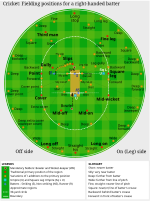Placements of players
- For more details on Fielding positions, see fielding positions in cricket.
 The standard fielding positions in cricket for a right-handed batsman. The spots are only indicative. Only nine fielders are available in addition to the bowler and wicketkeeper, so there are always many unprotected areas.
The standard fielding positions in cricket for a right-handed batsman. The spots are only indicative. Only nine fielders are available in addition to the bowler and wicketkeeper, so there are always many unprotected areas.
The team batting always has two batsmen on the field. One batsman, known as the striker, faces and plays the balls bowled by the bowler. His or her partner stands at the bowling end and is known as the non-striker.
The fielding team has all eleven of its players on the ground, and at any particular time, one of these will be the bowler. The player designated as bowler must change after every over. The wicket-keeper, who generally acts in that role for the whole innings, stands or crouches behind the wicket at the batting end. The captain of the fielding team spreads his or her remaining nine players — the fielders — around the ground to cover most of the area. Their placement may vary dramatically depending on strategy. Each position on the field has a unique label.
No comments:
Post a Comment